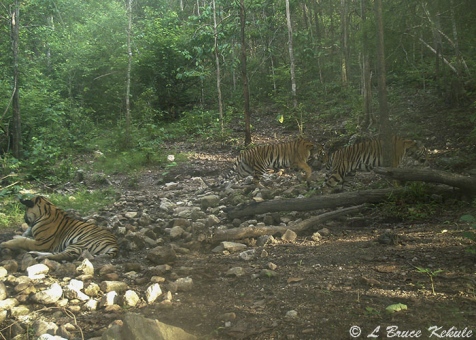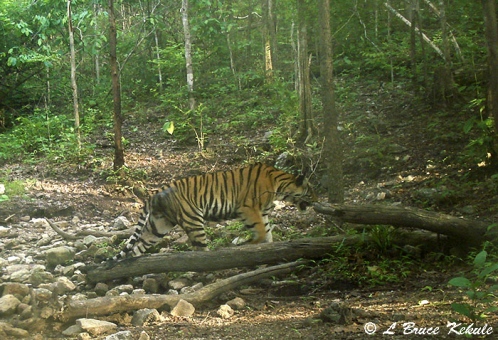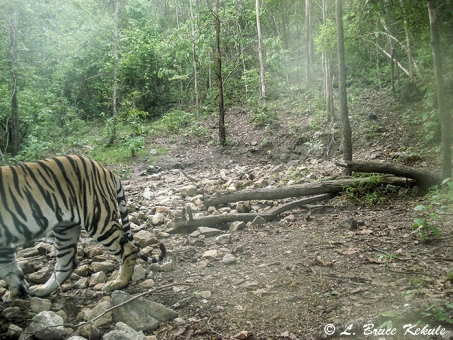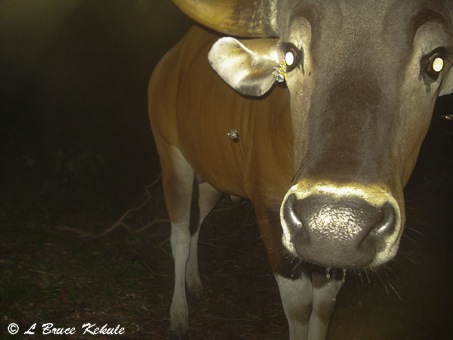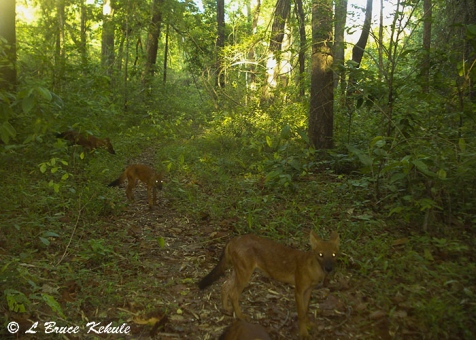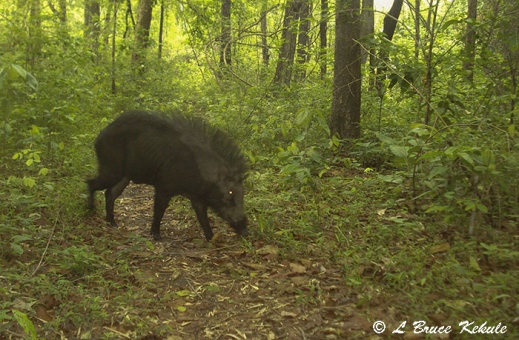Posts Tagged ‘wild cattle’
‘Battered’ Banteng Bull
A short video and camera trap photos of a banteng bull in the ‘Western Forest Complex’ of Thailand. My Nikon D700 and a Bushnell Trophy Cam captured this seriously injured creature. This is ‘raw’ nature and could be disturbing to some…but this is the natural world and how it really is……!
TIGER AND BANTENG – Sony W30 set
Tiger mother and two full grown cubs.
Recently, I pulled a Sony W30 camera trap from a mineral deposit in the Western Forest Complex and found some amazing photos of a mother tiger and her two cubs. It is very rare to see a tiger family on a trail cam. These amazing creatures usually do not hang around when it starts flashing at them…but I got some great shots shown here.
Mother and cub.
The two cubs leaving the mineral deposit.
Mother on the way out.
Another tiger visits the camera.
Banteng have now become quite rare in Southeast Asia but thrive in two wildlife sanctuaries in Thailand; one in the east and one in the west. Here are some shots of these beautiful wild cattle. The old bull looks like he is having a heck of time with the moths.
Banteng herd at the mineral deposit.
Old banteng bull and moths after a big rain.
A Close Encounter: The saga of a charging bull gaur
Gaur: Thailand’s magnificent mega-fauna
A truly close call with the largest bovid in the world…!
A bull gaur camera trapped at the trail-head a week before about 100 meters from where I was charged. Probably the same old bull that tried to kill me…!!
About two weeks ago, I hit the jackpot out of all my 48 years in Thai forests. I was alone and it was raining in the Western Forest Complex. I had just set a Bushnell Trophy Cam set to video at a trail-head where I previously got a big bull gaur, a bull banteng, elephant, black leopard, wild dog, tapir, wild pig and barking deer.
As I was walking in to set a few more traps, I saw some fresh gaur tracks and judging from the size, noted it was a big mature bull. I went in a little bit more and decided to turn back as the bush was really thick and it was getting late.
A mature bull banteng on the trail.
I had gone about 50 meters and all of a sudden, a bull gaur no more than six meters away, snorted at me. I snorted back thinking he would run away. In the next moment, this huge beast punched through the bush with its head down in the classic position to hook bad people and throw me into the trees.
I saw the right horn base for a fraction of a second and it took me another fraction of a second to do the only thing possible and that was to drop down to the left flat on my stomach with my head down. The bull jumped over my legs and then circled around to do more business of trying to kill me.
What seemed like a lifetime, I heard him thrashing around breaking saplings and stamping on the ground some 10 to 15 meters away. A second charge was imminent and could be disastrous if he used his hooves to trample me. Only one thing would save me now.
Banteng bull close-up.
I quickly pulled out my pistol (.45-ACP ‘Para-Ordnance’ alloy frame), loaded it and let off a shot in the air all the while still lying down. After the report a few seconds later, the bull high-tailed it crashing off into the forest behind me. WOW, that was a close encounter and truly a heart-stopper. I stayed on the ground for quite awhile to make sure he was really gone.
In all my years in the forest, I have never been this close to a gaur or had the experience of a charging bull. No telling if this old bovid had been shot and wounded previously by poachers, and that he really hated humans. Or was he just an old guy with a bad temper and considered me a threat when I barked back at him. I will never really know how close I came to instant death…!
Many a Thai hunter has been killed by gaur because they froze in their tracks and just stood there not reacting in time. I have read in several books that the only way to avert death is to drop flat on all fours with your head down, or to have a very large caliber rifle (minimum .458 caliber) on ready. I had a Nikon D7000 and a 70-300 VR lens. I was lucky to be packing a sidearm..!!
A black leopard close-up.
How did I react so fast and survive? I have one man to thank. He is my dear old friend Gordon Young, author of the book ‘Tracks of an Intruder’, a classic tome about hunting in northern Thailand in the 1950s. He talks about the evasive action needed in this urgent situation in a chapter about a man-killer bull gaur in Mae Salak in Chiang Mai, Northern Thailand. I certainly thought of him right after this…!
I feel extremely lucky to have survived this attack and it was absolutely the most exciting experience that I have ever had, bar none! I have been two meters away from a black leopard just outside my blind, and that did not even hold a candle to this charging solitary bull. I certainly did not have time to take a photo.
Maybe being born under the star ‘Taurus’ (May 19th) had something to do with it, or maybe the ‘good old spirits’ of the Thai forests took care of me and pushed me down at the right moment. This incident surely has me thanking my lucky star.
Asian wild dog pack out hunting.
Gaur are wild forest ox and the largest bovid in the world standing 1.7 meters at the shoulder weighing close to a ton for mature bulls with a distinctive dorsal ridge and a large dewlap, forming a very powerful appearance. Cows are only about 10cm shorter in height, but are more lightly built and weigh 150 kilograms less.
These beasts have stout limbs with white or yellow stockings from the knee to the hoof. The tail is long and the tip is tufted to ward-off biting insects. Newborns are a light golden color, but soon darken to coffee or reddish brown. Old bulls and cows are jet black but south of the Istamas of Kra, some take on a reddish hue.
All bovine share common features, such as strong defensive horns that never shed on males and females, as well as teeth and four-chambered stomachs adapted to chewing and digesting grass. Their long legs and two-toed feet are designed for fast running and agile leaping to escape predators. They are gregarious animals, staying in herds of six to 20, or more. A large herd of 50 was recorded in Thung Yai Naresuan Wildlife Sanctuary but that was a long time ago.
Wild boar in the morning.
Due to their formidable size and power, gaur has few natural enemies. Tiger, leopard and Asian wild dog packs occasionally attack unguarded calves or unhealthy animals, but only the tiger has been reported to kill a full-grown adult. Man is their most dangerous adversary.
These herbivores graze on grass but also browse edible shrubs, leaves and fallen fruit, and usually feed through the night. They also visit mineral licks to supplement their diet. During the day, they rest-up in deep shade.
A male muntjac (barking deer) with a serious wound on its hind quarter.
Gaur still survive in some protected areas but are in serious decline. It is now estimated that maybe 1000 remain in Thailand. However, some reserves where gaur are breeding in fairly good numbers allowing them to actually increase in number if there is adequate protection.
These enormous beasts live in herds but also become solitary, primarily the males. But I have also seen and photographed several mature females by themselves. Mineral deposits play a very important role in the lives of these wild cattle as does thick forests and steep mountainous terrain with abundant water resources. Their future depends whether they are protected to the fullest extent. Unfortunately, their beautifully curved horns are highly sought after by poachers and people who covet trophies.
A unarmed researcher a day before the big gaur passed by.
Budgets, better funding, more rangers and personnel are needed now. Transparency is a must with the national parks and wildlife sanctuaries so money is used properly and efficiently, and corruption stamped out completely. Now that will be a tough nut to crack. It is hoped this draconian situation will change, so the Kingdom’s natural heritage and the majestic gaur will continue to survive in today’s world.
Additional photos of gaur:
My first encounter with a bull gaur some 15 years ago.
The older bull being chased by a younger one.
Another old bull gaur at a waterhole.
A single gaur cow at a mineral deposit.
Gaur herd including a bull, cows and three calves.
A gaur herd including two banteng in Kui Buri National Park.
A bull gaur track on the right and cow track above.


